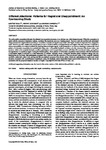Different Attentional Patterns for Regret and Disappointment: An Eye‐tracking Study
| dc.contributor.author | Bault, Nadège | |
| dc.contributor.author | Wydoodt, P | |
| dc.contributor.author | Coricelli, G | |
| dc.date.accessioned | 2020-01-09T14:18:21Z | |
| dc.date.available | 2020-01-09T14:18:21Z | |
| dc.date.issued | 2016-04-07 | |
| dc.identifier.issn | 0894-3257 | |
| dc.identifier.issn | 1099-0771 | |
| dc.identifier.uri | http://hdl.handle.net/10026.1/15295 | |
| dc.description.abstract |
<jats:title>Abstract</jats:title><jats:p>The unfavorable comparison between the obtained and expected outcomes of our choices may elicit disappointment. When the comparison is made with the outcome of alternative actions, emotions like regret can serve as a learning signal. Previous work showed that both anticipated disappointment and regret influence decisions. In addition, experienced regret is associated with higher emotional responses than disappointment. Yet it is not clear whether this amplification is due to additive effects of disappointment and regret when the outcomes of alternative actions are available, or whether it reflects the learning feature of regret signals. In this perspective, we used eye‐tracking to measure the visual pattern of information acquisition in a probabilistic lottery task. In the partial feedback condition, only the outcome of the chosen lottery was revealed, while in the complete feedback condition, participants could compare their outcome with that of the non‐chosen lottery, giving them the opportunity to experience regret. During the decision phase, visual patterns of information acquisition were consistent with the assessment of anticipated regret, in addition to a clear assessment of lotteries' expected values. During the feedback phase, subjective ratings and eye‐tracking results confirmed that participants compared their outcome with the outcome of the non‐chosen lottery in the complete feedback condition, particularly after a loss, and ignored the non‐realized outcome of the chosen option. Moreover, participants who made more visual saccades consistent with counterfactual comparisons during the feedback period anticipated regret more in their decisions. These results are consistent with the proposed adaptive function of regret. © 2016 The Authors Journal of Behavioral Decision Making Published by John Wiley & Sons Ltd.</jats:p> | |
| dc.format.extent | 194-205 | |
| dc.format.medium | Print-Electronic | |
| dc.language | en | |
| dc.language.iso | eng | |
| dc.publisher | Wiley | |
| dc.subject | decision making under risk | |
| dc.subject | regret | |
| dc.subject | eye-tracking | |
| dc.subject | neuroeconomics | |
| dc.title | Different Attentional Patterns for Regret and Disappointment: An Eye‐tracking Study | |
| dc.type | journal-article | |
| dc.type | Journal Article | |
| plymouth.author-url | https://www.webofscience.com/api/gateway?GWVersion=2&SrcApp=PARTNER_APP&SrcAuth=LinksAMR&KeyUT=WOS:000373309700008&DestLinkType=FullRecord&DestApp=ALL_WOS&UsrCustomerID=11bb513d99f797142bcfeffcc58ea008 | |
| plymouth.issue | 2-3 | |
| plymouth.volume | 29 | |
| plymouth.publication-status | Published | |
| plymouth.journal | Journal of Behavioral Decision Making | |
| dc.identifier.doi | 10.1002/bdm.1938 | |
| plymouth.organisational-group | /Plymouth | |
| plymouth.organisational-group | /Plymouth/Faculty of Health | |
| plymouth.organisational-group | /Plymouth/Faculty of Health/School of Psychology | |
| plymouth.organisational-group | /Plymouth/REF 2021 Researchers by UoA | |
| plymouth.organisational-group | /Plymouth/REF 2021 Researchers by UoA/UoA04 Psychology, Psychiatry and Neuroscience | |
| plymouth.organisational-group | /Plymouth/Users by role | |
| plymouth.organisational-group | /Plymouth/Users by role/Academics | |
| dc.publisher.place | England | |
| dcterms.dateAccepted | 2015-12-01 | |
| dc.identifier.eissn | 1099-0771 | |
| dc.rights.embargoperiod | Not known | |
| rioxxterms.versionofrecord | 10.1002/bdm.1938 | |
| rioxxterms.licenseref.uri | http://www.rioxx.net/licenses/all-rights-reserved | |
| rioxxterms.licenseref.startdate | 2016-04 | |
| rioxxterms.type | Journal Article/Review |


